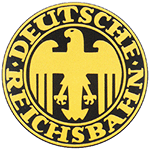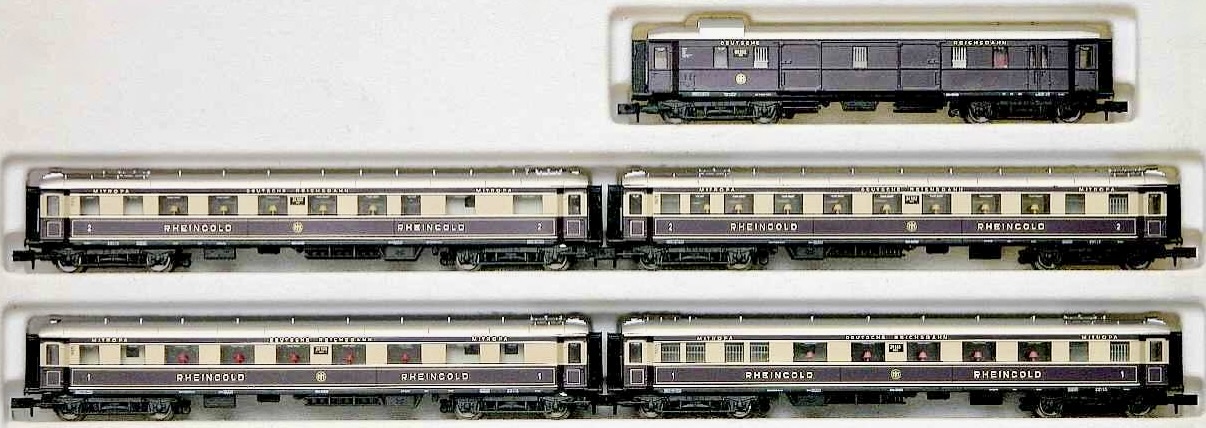Road Name History:  The Deutsche Reichsbahn, also known as the German Reich Railway or the German Imperial Railway, was the name of the German national railway created from the railways of the individual states of the German Empire following the end of World War I.
The Deutsche Reichsbahn, also known as the German Reich Railway or the German Imperial Railway, was the name of the German national railway created from the railways of the individual states of the German Empire following the end of World War I.
The company was founded in 1920 as the Deutsche Reichseisenbahnen when the Weimar Republic, formally known as Deutsches Reich (German Reich, hence the usage of the Reich in the name of the railway), took national control of the German railways, which had previously been run by the German states. In 1924 it was reorganised under the aegis of the Deutsche Reichsbahn-Gesellschaft (DRG), a nominally private railway company, which was 100% owned by the German state. In 1937 the railway was reorganised again as a state authority and given the name Deutsche Reichsbahn (DRB). After the Anschluss in 1938 the DR also took over the Bundesbahn Osterreich (BBO, Federal Railway of Austria).
The East and West German states were founded in 1949. East Germany took over the control of the DR on its territory and continued to use the traditional name Deutsche Reichsbahn, while the railway in West Germany became the Deutsche Bundesbahn (DB, German Federal Railway). The Austrian Osterreichische Bundesbahnen (OBB, Austrian Federal Railways) was founded in 1945, and was given its present name in 1947.
In January 1994, following the German union, the East German Deutsche Reichsbahn merged with the West German Deutsche Bundesbahn to form Germany's new national carrier, Deutsche Bahn AG, technically no longer a government agency but still a 100% state-owned joint stock company.

The company was founded in 1920 as the Deutsche Reichseisenbahnen when the Weimar Republic, formally known as Deutsches Reich (German Reich, hence the usage of the Reich in the name of the railway), took national control of the German railways, which had previously been run by the German states. In 1924 it was reorganised under the aegis of the Deutsche Reichsbahn-Gesellschaft (DRG), a nominally private railway company, which was 100% owned by the German state. In 1937 the railway was reorganised again as a state authority and given the name Deutsche Reichsbahn (DRB). After the Anschluss in 1938 the DR also took over the Bundesbahn Osterreich (BBO, Federal Railway of Austria).
The East and West German states were founded in 1949. East Germany took over the control of the DR on its territory and continued to use the traditional name Deutsche Reichsbahn, while the railway in West Germany became the Deutsche Bundesbahn (DB, German Federal Railway). The Austrian Osterreichische Bundesbahnen (OBB, Austrian Federal Railways) was founded in 1945, and was given its present name in 1947.
In January 1994, following the German union, the East German Deutsche Reichsbahn merged with the West German Deutsche Bundesbahn to form Germany's new national carrier, Deutsche Bahn AG, technically no longer a government agency but still a 100% state-owned joint stock company.
Brand/Importer Information:  Founded in 1906 by Karl Arnold in Nuernberg, K. Arnold & Co. began its life producing tin toys and related items. They produced an extensive line of model ships, doll house items and other toys. In 1935, K. Arnold & Co. hired Max Ernst as their managing director. Ernst, not to be confused with the German realist artist of the same name, was a significant factor in the future of Arnold.
Founded in 1906 by Karl Arnold in Nuernberg, K. Arnold & Co. began its life producing tin toys and related items. They produced an extensive line of model ships, doll house items and other toys. In 1935, K. Arnold & Co. hired Max Ernst as their managing director. Ernst, not to be confused with the German realist artist of the same name, was a significant factor in the future of Arnold.
There are several distinct phases of Arnold's model train production. In the period of 1960 - 1962, Arnold marketed the Arnold Rapido 200 product line; this line was very crude yet it also was a sensation because of its much smaller size than TT.
The next phase was from 1963-1967, when the rapido product line begins to swing toward scale representations of the trains. It is during this period that the "Rapido Coupler" comes into production, beginning its widespread use by all model train manufacturers in N-Scale. It was in 1964 that the term "N-Scale" came into use. Between 1968 and 1970, rapido line of trains reached maturity, notably with its turntable and roundhouse. Arnold entered into a business relationship with the U.S. company Revell around 1968, beginning the marketing of Revell Rapido model trains. This relationship was marked by the beginning of production of more accurate North American prototype models by Arnold. This relationship continued for several years, ending in the late 1960s or early 1970s. Arnold continued their expanded production, with new models until the early 1990s.
On Max Ernst's 1976 retirement, Arnold employed perhaps 200 to 250 people, using three facilities in the Nurnberg area. The Company continued under family control until 1995, when Arnold went into bankruptcy and was sold to Rivarossi of Italy. Rivarossi, in turn, also went bankrupt, leading to the sale of all assets to Hornby of the United Kingdom. Production is carried out in China.

There are several distinct phases of Arnold's model train production. In the period of 1960 - 1962, Arnold marketed the Arnold Rapido 200 product line; this line was very crude yet it also was a sensation because of its much smaller size than TT.
The next phase was from 1963-1967, when the rapido product line begins to swing toward scale representations of the trains. It is during this period that the "Rapido Coupler" comes into production, beginning its widespread use by all model train manufacturers in N-Scale. It was in 1964 that the term "N-Scale" came into use. Between 1968 and 1970, rapido line of trains reached maturity, notably with its turntable and roundhouse. Arnold entered into a business relationship with the U.S. company Revell around 1968, beginning the marketing of Revell Rapido model trains. This relationship was marked by the beginning of production of more accurate North American prototype models by Arnold. This relationship continued for several years, ending in the late 1960s or early 1970s. Arnold continued their expanded production, with new models until the early 1990s.
On Max Ernst's 1976 retirement, Arnold employed perhaps 200 to 250 people, using three facilities in the Nurnberg area. The Company continued under family control until 1995, when Arnold went into bankruptcy and was sold to Rivarossi of Italy. Rivarossi, in turn, also went bankrupt, leading to the sale of all assets to Hornby of the United Kingdom. Production is carried out in China.
Item created by: CNW400 on 2022-09-22 09:57:07. Last edited by CNW400 on 2022-09-22 09:57:08
If you see errors or missing data in this entry, please feel free to log in and edit it. Anyone with a Gmail account can log in instantly.
If you see errors or missing data in this entry, please feel free to log in and edit it. Anyone with a Gmail account can log in instantly.







